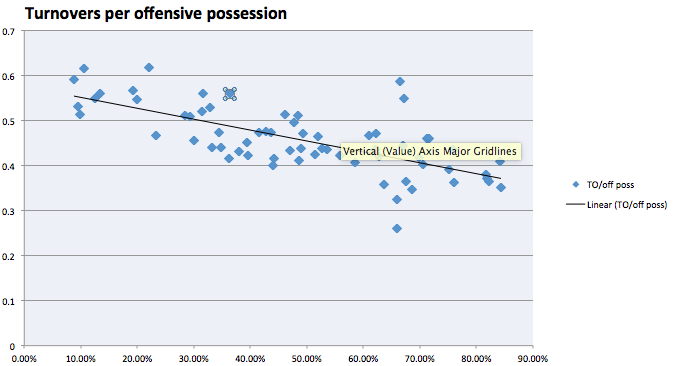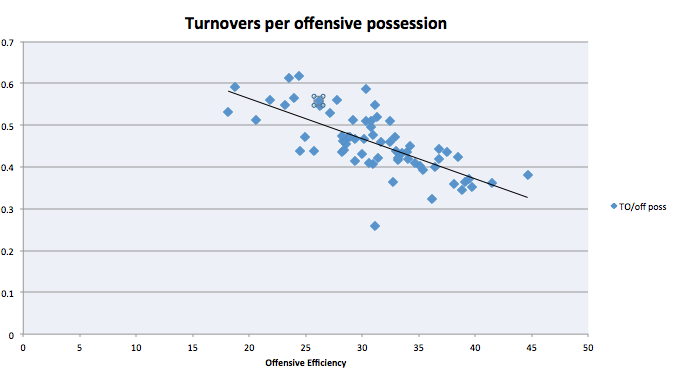Detroit’s story has been relatively consistent in the time I’ve been covering the team: The Titans have been very good defensively, but subpar on the offensive side of the ball. Bringing that portion of the team (rankings in the past four years: No. 46, 51, 55, 56 nationally from 2011-14) more in line with the other (Nos. 17, 34, 23, and 22 in the same span) can see the team make rapid improvement.
The Problem
Detroit has been, how shall we say, not very careful with the ball. The 2011 Titans turned it over on 61% of possessions. The 2012 team improved to only 58% of possessions ending with a turnover, with incremental improvement to 57.8 and 55.8% of possessions in the past two years.
That’s still not good enough, of course. Even those slow-but-steady improvements (which are natural with a young and improving program), the Titans ranked No. 59 of 66 in terms of turnovers per offensive possession last year – Quinnipiac’s stats are messed up thanks to inaccurate record keeping so I’ve excised them.
Here’s a look at turnovers per offensive possession (y-axis) plotted against team pythagorean win expectation (x-axis). The causal relationship isn’t exactly portrayed in the traditional way, but I’m not an Excel whiz and this made the data easier to digest. Detroit’s point on the chart is highlighted.
As you can see, The Titans were actually more successful than the trendline would otherwise expect them to be based on the number of turnovers they commit (teams above the line). Going to the more direct comparison – offensive efficiency – makes the point just as clearly. Again, the axes themselves are flipped in that the X is not the causal factor, but the trend is clear once again.
Again, I’ve highlighted Detroit’s mark, and it’s above the line once more. That means more of their (lack of) offensive success was due to turnovers than the average team. Trimming those up to fall along the trendline – and hopefully move down it to the right – will really help.
With a .261 offensive efficiency and .558 turnover rate, only about 18% of Titan possessions ended with something other than a UDM goal or turnover. Decreasing that 18% is tough – the other teams have defenses and goalies, you know – but chipping away at the 55.8% can lead to rapid improvement.
Very long side note, how about Penn State hanging out as a huge outlier to the bottom in both charts? A ton of their offensive success was due to never turning the ball over. Is that sustainable due to their style of play, or will the Nittany Lions take a slight step back on that side of the ball simply due to regression to the mean (in addition to their personnel losses in Shane Sturgis and Kyle Vanthof, among others)? Could just be some Tambroni magic that keeps up.
Factors
Now is the portion where blame is assigned. In some cases, that may be unfair (an offensive player who is asked to dominate the ball either offensively or as part of the clear is going to turn it over here and there), but the stats are the stats.
| Player | Turnovers |
|---|---|
| Alex Maini | 43 |
| Mike Birney | 30 |
| Brandon Beauregard | 23 |
| Shayne Adams | 19 |
| Scott Drummond | 19 |
| Tom Masterson | 14 |
Interactive Whiteboards by PolyVision
Alex Maini was very turnover-prone (though as mentioned above, there’s some give-and-take – he was the team’s leader in assists, and trying to make plays carries inherent risk). So too was Mike Birney, who was less important as a ball-carrier for the offense, but was involved in the Titans’ clear. That the clear itself was bad is its own issue, but turnovers played directly into it.
Speaking of that clear, 59 of the Titans’ 249 turnovers came on the clear (they had the fifth-worst clearing unit in the country). Those are doubly damaging because they not only rob the offense of a chance to score, but they also put the defense in a tough spot, opening them up to fast-break opportunities from the opponent. As good as the UDM defense was last year, it could have been even better if not for so many rideback opportunities for opponents (I count six direct rideback goals from the boxscores – by a pretty strict standard of a score coming within 15 seconds of the failed clear – including two in a one-goal loss to Quinnipiac).
With another year of experience for some of these guys, their should be more precision with their passing and decision-making, and hopefully stick skills overall. Again, it may be unfair to Maini – since he carried the team’s offense for much of the year – but if he’s simply as turnover-prone as it looks, maybe there’s a chance to replace his scoring and carrying ability with a bit more ball security, losing him may not hurt as much as the scoring totals (he was the team’s assist leader with 26, and second-leading scorer overall by adding 18 goals) would suggest.
Reasonable Expectations
There is something to be said for playing in the same system for two years (though less so in lacrosse, especially when promotions to offensive coordinator come from within the program than football or maybe even basketball). We’ve already seen Graham Adams work wonders with the UDM man-up – setting an NCAA record for success – last year. With more comfort in the way he does things, the Titans should be able to eliminate some of the first-year jitters.
While not directly related to offense, goalie Jason Weber also committed six turnovers last year. That’s not many for a goalie, but he was also a freshman, and one who missed the first three games. Another year of experience should help him clean even those limited mistakes up, or at the very least make it so they hurt both offense and his defense a little less.
As mentioned above, there are some other factors, such as graduating a couple of the more turnover-prone Titans, that could help to a degree. The Titans aren’t ever going to have the greatest sticks in the world, due to reliance on in-state recruiting, but they do have five incoming Canadians (two freshmen and three others coming off redshirts last year), and a hotbed player from DC Gonzaga available this year that they didn’t have last year that could help to a degree. That’s no hard-and-fast comparison – Midwest = good athletes, worse stick skills, Hotbed = better sticks – but as a rough estimation, it’ll do here.
Approaching the national average (.449 turnovers/offensive possession) is a reasonable goal. It probably means struggling mightily against the good teams but doing better in the MAAC. Since winning the league is the path to success for a mid-major team, that’s probably fine. 115 of the Titans’ 248 turnovers were unforced by the opposition, and simply getting that number below 100 would be a marked improvement.


